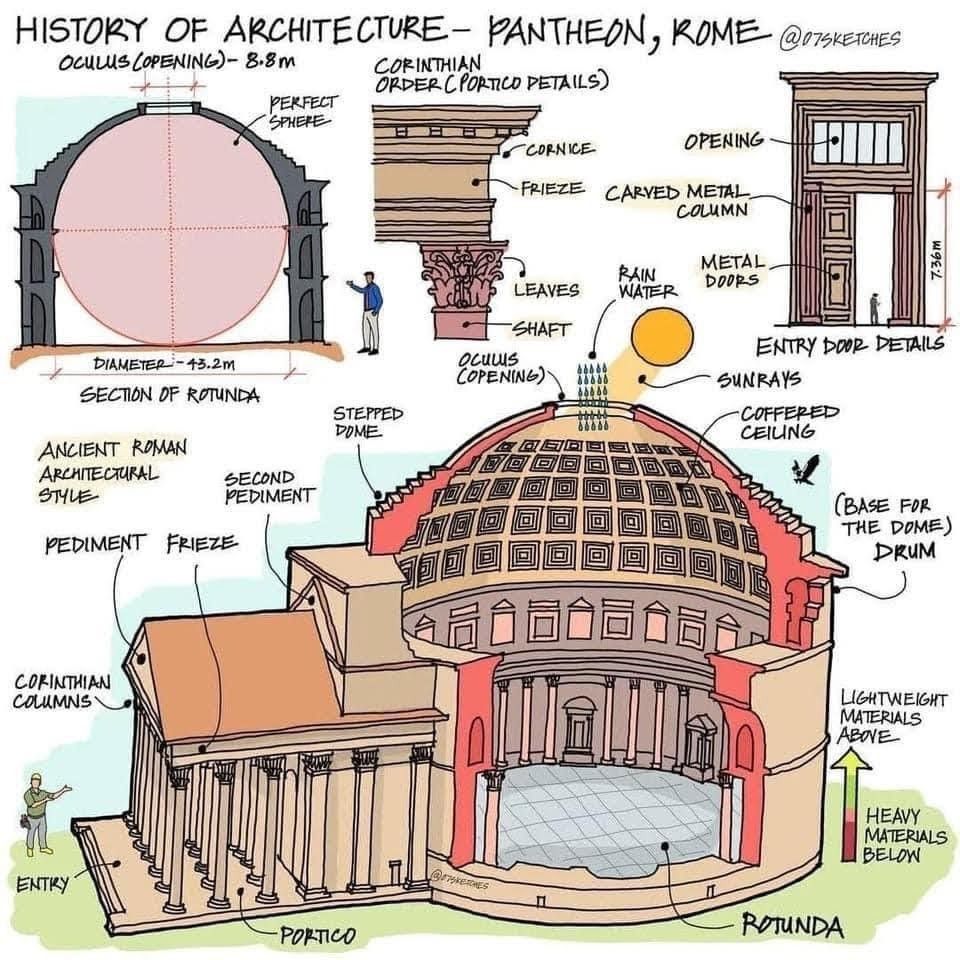From perfect geometry to advanced engineering, the Pantheon’s 43.2-meter dome continues to inspire architects and engineers nearly 2,000 years after its construction.
In the heart of Rome stands a monument that has defied time, gravity, and human imagination—the Pantheon. Built around 113–125 AD under Emperor Hadrian, the Pantheon is not just another Roman temple; it is a masterpiece of mathematical precision, architectural genius, and engineering innovation. With its enormous unreinforced concrete dome and the mysterious oculus at its center, the Pantheon remains the largest and most influential ancient dome in the world.
🏛️ The Structure That Defined an Era
🔹 The Portico
At first glance, visitors are greeted by a portico with Corinthian columns, exuding the grandeur of ancient Roman architectural style. Each column, intricately carved with leaves and details, supports the pediment and frieze—classic Roman symbols of power and divinity. This portico acts as a ceremonial entrance, preparing visitors for the wonder inside.
🔹 The Rotunda and Dome
Walking through the massive metal doors, one steps into the rotunda, crowned by the largest unreinforced concrete dome of antiquity, spanning an incredible 43.2 meters in diameter. The dome forms a perfect sphere when imagined in three dimensions, symbolizing the heavens.
The base, or drum, is built with heavy stone and concrete, while the upper dome transitions to lightweight volcanic materials, ensuring structural stability. This layering was an ancient Roman innovation, preventing collapse and distributing weight effectively.
☀️ The Oculus: A Portal to the Heavens
At the crown of the dome lies the oculus, an 8.8-meter-wide circular opening. Far from being a flaw, it is the Pantheon’s most profound feature. The oculus serves multiple purposes:
- 🌞 Light: It allows natural sunlight to move across the interior like a celestial spotlight, acting as a giant sundial.
- 💧 Rainwater Management: When rain falls through the oculus, it drains harmlessly through a carefully engineered floor system.
- 🌌 Symbolism: It represents the connection between Earth and the heavens, between mortals and gods.
🧱 Coffered Ceiling: Beauty Meets Engineering
The dome’s coffered ceiling—sunken rectangular panels—was not just decorative. This design reduced the weight of the dome while adding elegance and rhythm to the structure. Each coffer symbolically guides the eye upward, toward the heavens, emphasizing the cosmic theme of the building.
🔧 Engineering Genius of the Pantheon
The Pantheon is not only about grandeur but also about practical Roman engineering:
- Stepped Dome Construction: Layer by layer, the Romans distributed stress to prevent cracks.
- Material Innovation: Using a gradient of heavy materials below and lighter ones above was revolutionary.
- Perfect Geometry: The height to the oculus and the diameter of the dome are equal—43.2 meters—creating a perfect sphere within.
🌍 Legacy and Influence
For nearly two millennia, the Pantheon has remained a blueprint for architects worldwide. Renaissance masters like Brunelleschi studied it to design Florence’s Dome, while Michelangelo called it “angelic, not human” when planning St. Peter’s Basilica. Even modern buildings, from government structures to museums, borrow from its Corinthian columns, dome, and symmetry.
📜 Conclusion: A Living Monument
Today, the Pantheon is more than just an architectural relic. It serves as a church, a tourist destination, and a living classroom for engineers and architects. Standing in its rotunda, one can still feel the awe that Romans must have felt nearly 2,000 years ago.
The Pantheon is not just Rome’s treasure—it is humanity’s eternal dome, a symbol of how art, science, and spirituality can merge into timeless architecture.
